Killing me softly
Palu, Indonesia -- Every time I cover a disaster like this, a little piece of me is lost. The soft part of you, the part that feels, that cares, the human part I guess. It kills that part of you a bit. I can feel that it’s not as strong as it was before, when I first started being a photojournalist.
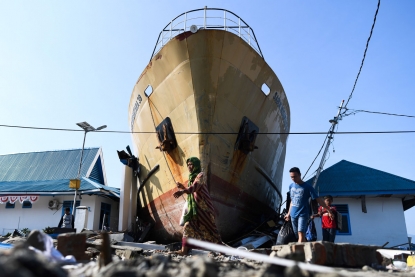 A ferry washed up on shore, Palu, October 3, 2018.
(AFP / Jewel Samad)
A ferry washed up on shore, Palu, October 3, 2018.
(AFP / Jewel Samad) A ferry washed up on shore, Palu, October 3, 2018. (AFP / Jewel Samad)
A ferry washed up on shore, Palu, October 3, 2018. (AFP / Jewel Samad)
The effects of the earthquake/tsunami in Indonesia was my eighth earthquake and second tsunami. I’ve covered wars, I’ve seen death. Plenty of it. I’ve seen my fair share of dead bodies. But there is something particularly unpleasant about covering the aftermath of a tsunami.
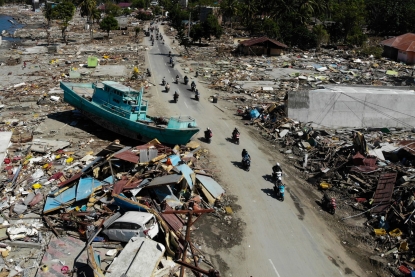 People drive past a washed up boat and collapsed buildings in Palu, Indonesia's Central Sulawesi on October 1, 2018, after an earthquake and tsunami hit the area on September 28. (AFP / Jewel Samad)
People drive past a washed up boat and collapsed buildings in Palu, Indonesia's Central Sulawesi on October 1, 2018, after an earthquake and tsunami hit the area on September 28. (AFP / Jewel Samad)It can be summed up in three things -- the smell, the death and the devastation. The smell is particularly horrible. I don’t know how to describe it, except to say that it is the smell of death and it is omnipresent, it seeps into everything, it follows you everywhere. I covered the 2004 Indian Ocean tsunami and sometimes, even after all these years, I still get nightmares about the smell. The smell was just as bad in Indonesia.
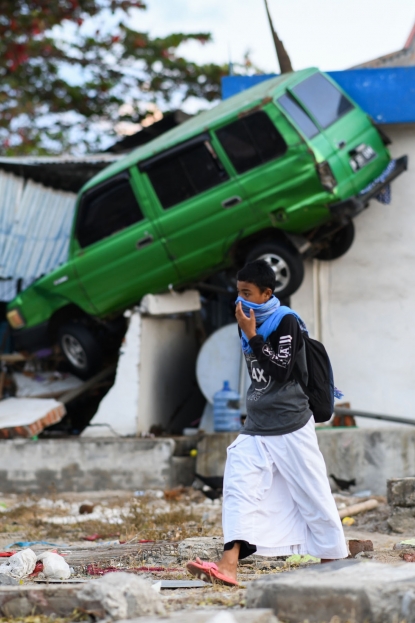 A survivor walks past a damaged area in Palu, Indonesia's Central Sulawesi on October 1, 2018, after an earthquake and tsunami hit the area on September 28. (AFP / Jewel Samad)
A survivor walks past a damaged area in Palu, Indonesia's Central Sulawesi on October 1, 2018, after an earthquake and tsunami hit the area on September 28. (AFP / Jewel Samad)When covering something like this, it doesn’t matter how much you prepare or how many times you’ve done it before. You gain experience because you know what to expect and what to do. But in terms of the trauma, you experience it more or less as if it were your first time. Maybe it’s just me. But I can never be ready to face something like this. I feel like I’m seeing it for the first time.
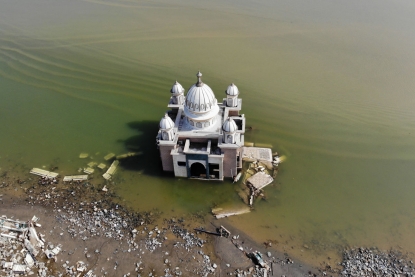 A damaged mosque, Palu, October 4, 2018. (AFP / Jewel Samad)
A damaged mosque, Palu, October 4, 2018. (AFP / Jewel Samad)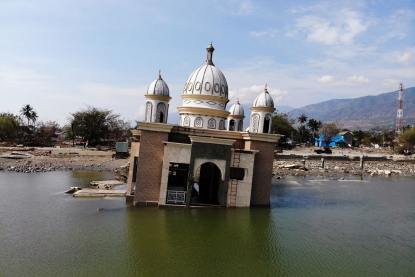 A damaged mosque, Palu, October 4, 2018. (AFP / Jewel Samad)
A damaged mosque, Palu, October 4, 2018. (AFP / Jewel Samad)
That said, I didn’t even think of not going when my editor called me. This is my job, this is what I do. And as much as I don’t like to do this particular part of the job, people need to know what is going on. As a journalist, this is the small part that I can play and I am happy to do it.
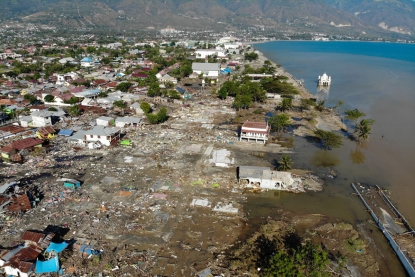 Aerial view of the devastation caused by an earthquake and tsunami in Palu, October 1, 2018. (AFP / Jewel Samad)
Aerial view of the devastation caused by an earthquake and tsunami in Palu, October 1, 2018. (AFP / Jewel Samad)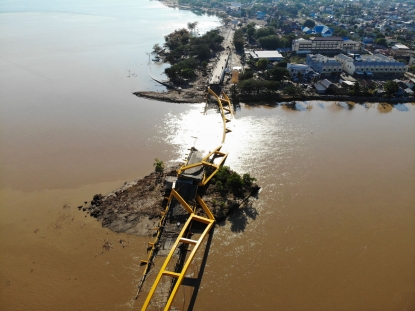 A collapsed bridge in Palu, October 1, 2018. (AFP / Jewel Samad)
A collapsed bridge in Palu, October 1, 2018. (AFP / Jewel Samad)
It took me almost two days to get to Palu from Bangkok, where I'm currently based. I first flew to Poso and then drove 12 hours to Palu. There were thousands of people trying to flee the city.
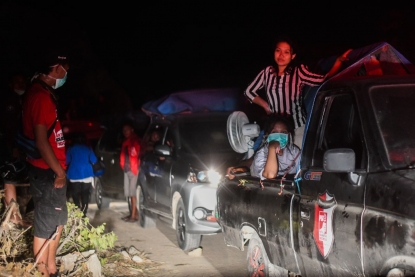 Residents stuck in a traffic jam trying to leave Palu after an earthquake and a tsunami, September 30, 2018. (AFP / Jewel Samad)
Residents stuck in a traffic jam trying to leave Palu after an earthquake and a tsunami, September 30, 2018. (AFP / Jewel Samad)At first, our conditions weren’t much better than those of the survivors. We spent the first night sleeping in the parking lot of an office building. We spent the first few days eating nothing but biscuits and water.
The first thing you do when you get to a disaster zone like this is take care of logistics. In order to work, you need a decent base, with electricity and hopefully food and water. It took us a bit to get settled. After the first night out in the parking lot, we spent the second night in a storage unit. Then we found a few rooms in a house that had a generator. But getting gasoline was very difficult, so we could use the generator mainly to charge our computers and phones. The woman who lived in the house cooked rice and chicken, which to us by that point was a gourmet meal.
 Survivors line up at a gas station to get gasoline, Palu, October 1, 2018. (AFP / Jewel Samad)
Survivors line up at a gas station to get gasoline, Palu, October 1, 2018. (AFP / Jewel Samad)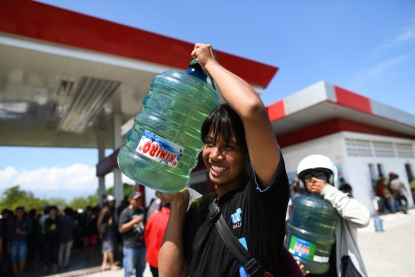 Carrying gasoline in water containers, Palu, October 1, 2018. (AFP / Jewel Samad)
Carrying gasoline in water containers, Palu, October 1, 2018. (AFP / Jewel Samad)
Of course whatever difficulties we had paled in comparison to what the locals had to deal with.
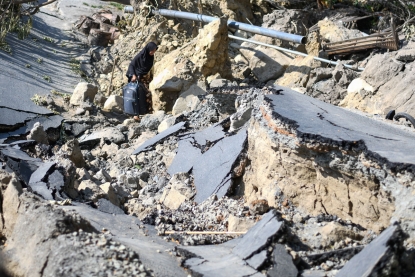 A woman with a suitcase makes her way along a destroyed road in Palu, Indonesia's Central Sulawesi on October 2, 2018. (AFP / Jewel Samad)
A woman with a suitcase makes her way along a destroyed road in Palu, Indonesia's Central Sulawesi on October 2, 2018. (AFP / Jewel Samad)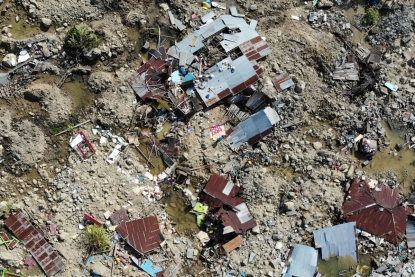 Survivors salvage useable items from the debris of a destroyed house in Palu, Indonesia's Central Sulawesi on October 2, 2018. (AFP / Jewel Samad)
Survivors salvage useable items from the debris of a destroyed house in Palu, Indonesia's Central Sulawesi on October 2, 2018. (AFP / Jewel Samad)
One of the worst things for me to cover in a disaster like this is the mass graves. With so many dead and with the hot weather, and with the destruction, you just can’t bury everyone individually. So they have to be buried in a mass grave. As it that wasn’t bad enough, this time technology made it even worse.
Part of my regular job now involves using a drone. You can’t beat the images from above, they give you a completely different perspective.
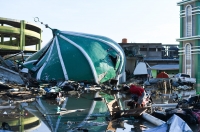

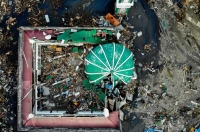
But when that perspective is of a mass grave, it can be quite a shocker. It’s one thing to see a burial like that from the side. When you see it from above, you really get the scale. Because of the drone, this tsunami has had more of an effect on me than that of 2004. While the 2004 one may have been bigger in scope and destruction, because of the drone, I got to see more of the effect that this one had.
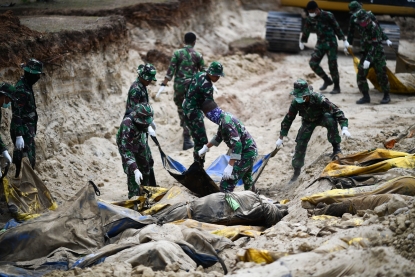 Indonesian soldiers bury quake victims in a mass grave in Poboya in Indonesia's Central Sulawesi on October 2, 2018. (AFP / Jewel Samad)
Indonesian soldiers bury quake victims in a mass grave in Poboya in Indonesia's Central Sulawesi on October 2, 2018. (AFP / Jewel Samad)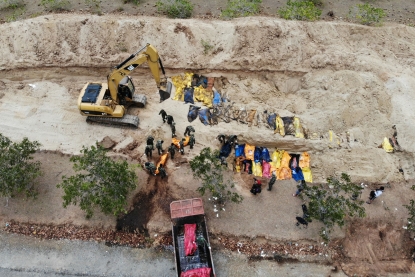 Aerial photo of soldiers burying victims in a mass grave in Poboya in Indonesia's Central Sulawesi on October 2, 2018. (AFP / Jewel Samad)
Aerial photo of soldiers burying victims in a mass grave in Poboya in Indonesia's Central Sulawesi on October 2, 2018. (AFP / Jewel Samad)
I try my best after taking such pictures not to think about them. When small kids are begging for money in the street, I try to delete that from my memory. But it doesn’t work all the time. I try not to think about these things when I go home, but they come back. When you see kids and you have kids of your own, you can’t help but think “That could be us. That could be anyone.” Whenever I began to think of my daughters I would get goose bumps. If anything happened to them, I don’t know how I would cope with that. I can’t even think about it.
 Young victim, Palu, October 4, 2018. (AFP / Jewel Samad)
Young victim, Palu, October 4, 2018. (AFP / Jewel Samad) Children beg along a road in Donggala in Indonesia's Central Sulawesi on October 5, 2018. (AFP / Jewel Samad)
Children beg along a road in Donggala in Indonesia's Central Sulawesi on October 5, 2018. (AFP / Jewel Samad)
But you just plow through. You try not to think too much, but just do the job, deal with the smell, long enough to take the picture and then look away. You try that not too much of that soft part of you gets killed every time. You don’t want that human side of you getting harder, like a rock, that’s not a good thing.
So I tell myself -- there is nothing that I can change about this. All I can do is my job. To tell the world what is going on here. And try to delete the hardest images from my mind.
This blog was written with Yana Dlugy in Paris.
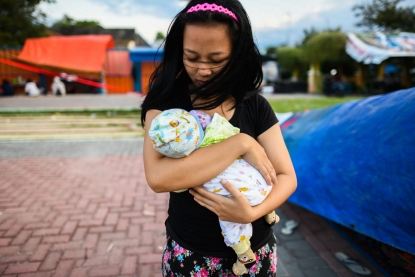 A quake survivor cradles her two-month-old son at a makeshift camp in Palu in Indonesia's Central Sulawesi on October 2, 2018. (AFP / Jewel Samad)
A quake survivor cradles her two-month-old son at a makeshift camp in Palu in Indonesia's Central Sulawesi on October 2, 2018. (AFP / Jewel Samad)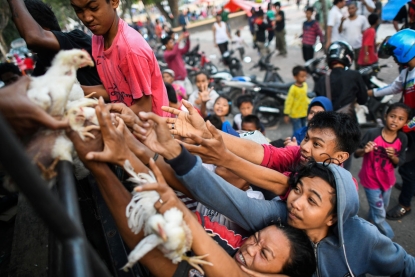 Quake survivors scuffle to get live chickens being distributed from a police truck outside a makeshift camp in Palu in Indonesia's Central Sulawesi on October 2, 2018. (AFP / Jewel Samad)
Quake survivors scuffle to get live chickens being distributed from a police truck outside a makeshift camp in Palu in Indonesia's Central Sulawesi on October 2, 2018. (AFP / Jewel Samad)


